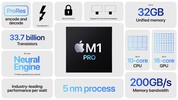Apple M1 Pro vs AMD Ryzen 9 5980HS vs Apple M1 Max
Apple M1 Pro
► remove from comparison
The Apple M1 Pro is a System on a Chip (SoC) from Apple that is found in the late 2021 MacBook Pro 14 and 16-inch models. It offers all 10 cores available in the chip divided in eight performance cores (P-cores with 600 - 3220 MHz) and two power-efficiency cores (E-cores with 600 - 2064 MHz). There is no Turbo Boost for single cores or short burst periods. The cores are similar to the cores in the Apple M1. The entry level model offers only 8 cores.
The big cores (codename Firestorm) offer 192 KB instruction cache, 128 KB data cache, and 24 MB shared L2 cache (up from 12 MB in the M1). The four efficiency cores (codename Icestorm) are a lot smaller and offer only 128 KB instruction cache, 64 KB data cache, and 4 MB shared cache. CPU and GPU can both use the 24 MB SLC (System Level Cache). The efficiency cores (E cluster) clock with 600 - 2064 MHz, the performance cores (P cluster) with 600 - 3228 MHz.
The unified memory (16 or 32 GB LPDDR5-6400) next to the chip is connected by a 256 bit memory controller (200 GB/s bandwidth) and can be used by the GPU and CPU.
The integrated graphics card in the M1 Pro offers all 16 cores.
Furthermore, the SoC integrates a fast 16 core neural engine, a secure enclave (e.g., for encryption), a unified memory architecture, Thunderbolt 4 controller, an ISP, and media de- and encoders (including ProRes).
The M1 Pro is manufactured in 5 nm at TSMC and integrates 33.7 billion transistors. The peak power consumption of the chip was advertised around 30W for CPU intensive tasks. In the Prime95 benchmark the chip uses in our tests (with a MBP16) 33.6W package power and 31W for the CPU part. In idle the SoC only reports 1W package power.
AMD Ryzen 9 5980HS
► remove from comparison
The AMD Ryzen 9 5980HS is a processor for big (gaming) laptops based on the Cezanne generation. The R9 5980HS integrates all eight cores based on the Zen 3 microarchitecture. They are clocked at 3 GHz (guaranteed base clock) to 4.8 GHz (Turbo) and support SMT / Hyperthreading (16 threads). The chip is manufactured on the modern 7 nm process at TSMC. Compared to the 5980HX (up to 54 W), the 5980HS is configured to a TDP of 35W and offers a 300 MHz reduced base speed.
The new Zen 3 microarchitecture offers a significantly higher IPC (instructions per clock) compared to Zen 2. For desktop processors AMD claims 19 percent on average and in applications reviews showed around 12% gains at the same clock speed.
With the increased clock speed and IPC improvements thanks to Zen 3, the Ryzen 9 5980HS should be clearly faster than the lower clocked Ryzen 9 4900H.
In addition to the eight CPU cores, the APU also integrates a Radeon RX Vega 8 integrated graphics card with 8 CUs and up to 2100 MHz. The dual channel memory controller supports DDR4-3200 and energy efficient LPDDR4-4266 RAM. Furthermore, 16 MB level 3 cache can be found on the chip.
The TDP of the APU is specified at 35 Watt and therefore suited for smaller laptops than the 5980HX (35 - 52W, default 45W).
Apple M1 Max
► remove from comparison
The Apple M1 Max is a System on a Chip (SoC) from Apple that is found in the late 2021 MacBook Pro 14 and 16-inch models. It offers all 10 cores available in the chip divided in eight performance cores (P-cores with 600 - 3220 MHz) and two power-efficiency cores (E-cores with 600 - 2064 MHz). There is no Turbo Boost for single cores or short burst periods. The cores are similar to the cores in the Apple M1.
The big cores (codename Firestorm) offer 192 KB instruction cache, 128 KB data cache, and 24 MB shared L2 cache (up from 12 MB in the M1). The four efficiency cores (codename Icestorm) are a lot smaller and offer only 128 KB instruction cache, 64 KB data cache, and 4 MB shared cache. CPU and GPU can both use the 48 MB SLC (System Level Cache). The efficiency cores (E cluster) clock with 600 - 2064 MHz, the performance cores (P cluster) with 600 - 3228 MHz.
The unified memory (32 or 64 GB LPDDR5-6400) next to the chip is connected by a 512 bit memory controller (200 GB/s bandwidth) and can be used by the GPU and CPU. This is the main difference to the M1 Pro and the CPU performance is quite similar.
The biggest difference to the M1 Pro is the bigger integrated GPU with 24 or 32 cores (up from 16).
Furthermore, the SoC integrates a fast 16 core neural engine, a secure enclave (e.g., for encryption), a unified memory architecture, Thunderbolt 4 controller, an ISP, and media de- and encoders (including two ProRes engines).
The M1 Pro is manufactured in 5 nm at TSMC and integrates 57 billion transistors. The peak power consumption of the chip was advertised around 30W for CPU intensive tasks.
| Model | Apple M1 Pro | AMD Ryzen 9 5980HS | Apple M1 Max | ||||||||||||||||||||||||||||||||||||||||||||||||
| Series | Apple M1 | AMD Cezanne (Zen 3, Ryzen 5000) | Apple M1 | ||||||||||||||||||||||||||||||||||||||||||||||||
| Series: M1 |
|
|
| ||||||||||||||||||||||||||||||||||||||||||||||||
| Clock | 2064 - 3220 MHz | 3000 - 4800 MHz | 2060 - 3220 MHz | ||||||||||||||||||||||||||||||||||||||||||||||||
| L1 Cache | 2.9 MB | 512 KB | 2.9 MB | ||||||||||||||||||||||||||||||||||||||||||||||||
| L2 Cache | 28 MB | 4 MB | 28 MB | ||||||||||||||||||||||||||||||||||||||||||||||||
| L3 Cache | 24 MB | 16 MB | 48 MB | ||||||||||||||||||||||||||||||||||||||||||||||||
| Cores / Threads | 10 / 10 | 8 / 16 | 10 / 10 | ||||||||||||||||||||||||||||||||||||||||||||||||
| Transistors | 33700 Million | 57000 Million | |||||||||||||||||||||||||||||||||||||||||||||||||
| Technology | 5 nm | 7 nm | 5 nm | ||||||||||||||||||||||||||||||||||||||||||||||||
| Features | ARMv8 Instruction Set | DDR4-3200/LPDDR4-4266 RAM, PCIe 3, MMX, SSE, SSE2, SSE3, SSSE3, SSE4A, SSE4.1, SSE4.2, AVX, AVX2, BMI2, ABM, FMA, ADX, SMEP, SMAP, SMT, CPB, AES-NI, RDRAND, RDSEED, SHA, SME | ARMv8 Instruction Set | ||||||||||||||||||||||||||||||||||||||||||||||||
| iGPU | Apple M1 Pro 16-Core GPU | AMD Radeon RX Vega 8 (Ryzen 4000/5000) ( - 2100 MHz) | Apple M1 Max 32-Core GPU | ||||||||||||||||||||||||||||||||||||||||||||||||
| Architecture | ARM | x86 | ARM | ||||||||||||||||||||||||||||||||||||||||||||||||
| Announced | |||||||||||||||||||||||||||||||||||||||||||||||||||
| Codename | Cezanne-HS (Zen 3) | ||||||||||||||||||||||||||||||||||||||||||||||||||
| TDP | 35 Watt | ||||||||||||||||||||||||||||||||||||||||||||||||||
| max. Temp. | 105 °C | ||||||||||||||||||||||||||||||||||||||||||||||||||
| Socket | FP6 | ||||||||||||||||||||||||||||||||||||||||||||||||||
| Manufacturer | www.amd.com |
Benchmarks
Average Benchmarks Apple M1 Pro → 100% n=12
Average Benchmarks AMD Ryzen 9 5980HS → 104% n=12
Average Benchmarks Apple M1 Max → 99% n=12
* Smaller numbers mean a higher performance
1 This benchmark is not used for the average calculation













